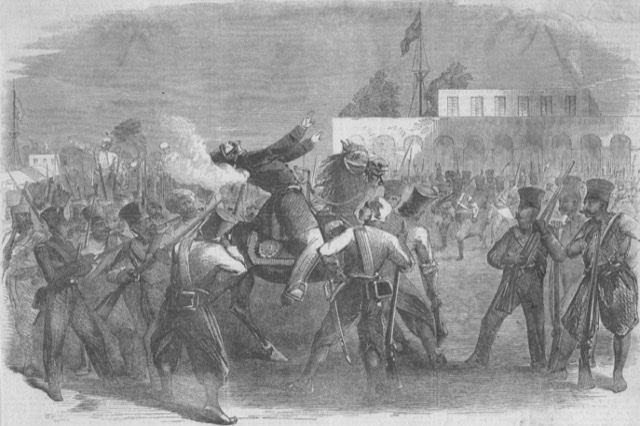
Saquib Salim/New Delhi
Small parties of cavalry troopers, with cries of ‘Yah Allah’, and ‘Deen Deen’ (Religion Religion) rushed into the city and called upon the people to join.” This is how F. Williams, the commissioner of Meerut, described the opening scene of the First War of National Independence on 10 May, 1857 AD, or 16 Ramadan, 1273 AH.
By 1857, Indians were planning a national revolt for at least a decade. In 1845, officers of the English East India Company had already unearthed a plan for a national revolt being plotted by several influential Indians. Khwaja Hasan Ali Khan was charged for trying to seduce the Indian sepoys of the English army into mutiny.
For months, Indian zamindar, raja, nawab, fakir, sadhu and influential people were preparing ground for a large-scale uprising against the foreign rulers. Kunwar Singh wrote to Zulfiqar about reaching Meerut for a war as early as 1856. English officers later noted that for almost an year fakirs and sadhus roamed across the country to instill nationalism among Indians. Meerut was important. Defeating English at Meerut would be a psychological blow for them.
Malleson noted that, “it was one of the largest and most important in the whole range of our Indian territories. There, troops of all arms, both European and Native, were assembled. There, the Headquarters of the Bengal Artillery were established. There, the Ordnance Commissariat were diligently employed, in the Expense Magazine, on the manufacture of greased cartridges.”
Moreover, it was one of those few cantonments where the number of European soldiers was at parity with the Indian soldiers. In April, 1857, a Fakir riding an elephant camped himself in Meerut.
It is believed that it was this Fakir who persuaded sepoys to boycott the cartridges and revolt against the English. At the morning parade on 24 April, 90 sepoys of 3rd Regiment, Light Cavalry, were ordered by Colonel Smith to load their Enfield Rifles with cartridges. All but five of them declined to obey the order. These 85 sepoys were imprisoned and court martialled. A day before this, Brijmohan, a sepoy loyal to Colonel Smith had publicly bitten the cartridge packing to instill confidence among Indians. On the night before the parade his house was burnt down by the revolutionaries.
The die was cast. On 9 May, all of these 85 sepoys were sentenced to jail terms by Major General Hewit. It must be noted that among them 49 were Muslims and 36 were Hindus. The revolt was, right from the outset, truly secular. The name of all these 80 Indian sepoys who defied the English command and thus triggered the first national war of Independence from Meerut. 1. Mataa-Deen (Havildar) Naiks: 1. Sheikh Peer Ali 2. Ameer Qudrat Ali 3. Sheikh Hasan ud-Deen 4. Sheikh Noor Muhammad Sepoys: 1. Sheetal Singh 2. Jehangir Khan 3. Meer Mosim Ali 4. Ali Noor Khan 5. Meer Husain Bakhsh 6. Muttra Singh 7. Narain Singh 8. Lal Singh 9. Sewdeen Singh 10. Sheikh Husain Bakhsh 11. Sahibdad Khan 12. Bishan Singh 13. Baldeo Singh 14. Sheikh Nandoo 15. Nawab Khan 16. Sheikh Ramzan Ali 17. Ali Mohammad Khan 18. Makhan Singh 18. Makhan Singh 19. Durga Singh 20. Nasurullah Begh 21. Meerahib Khan 22. Durga Singh (2nd) 23. Nabi Bakhsh Khan 24. Jurakhan Singh 25. Nadju Khan 26. Jurakhan Singh (2nd) 27. Abdullah Khan 28. Ehsan Khan 29. Zabardast Khan 30. Murtaza Khan 31. Burjuar Singh 32. Azimullah Khan 33. Azimullah Khan (2nd) 34. Kalla Khan 35. Sheikh Sadullah 36. Salar Bakhsh Khan 37. Sheikh Rahat Ali 38. Dwarka Singh 39. Kalka Singh 40. Raghubir Singh 41. Baldeo Singh 42. Darshan Singh 43. Imdad Husain 44. Peer Khan 45. Moti Singh 46. Sheikh Fazal Imam 47. Sewa Singh 48. Heera Singh 49. Murad Sher Khan 50. Sheikh Aram Ali 51. Kashi Singh 52. Ashraf Ali Khan 53. Qadardad Khan 54. Sheikh Rustam 55. Bhagwan Singh 56. Meer Imdad Ali 57. Shiv Baksh Singh 58. Lakshman Singh 59. Sheikh Imam Bakhsh 60. Usman Khan 61. Maqsood Ali Khan 62. Sheikh Ghazi Bakhsh 63. Sheikh Ommaid Ali 64. Abdul Wahab Khan 65. Ram Sahai Singh 66. Parna Ali Khan 67. Lakshman Dubey 68. Ramswaran Singh 69. Sheikh Azad Ali 70. Shiv Singh 71. Sheetal Singh 72. Mohan Singh 73. Vilayat Ali Khan 74. Sheikh Muhammad Ewaz 75. Indar Singh 76. Fateh Khan 77. Maiku Singh 78. Sheikh Qasim Ali 79. Ramcharan Singh 80. Daryao Singh
On 10 May, the sepoys attacked the jail to free the jailed sepoys. The whole city knew that they had to rise. Pandit Kanhayya Lal wrote that there were meetings in the city on the night of 9 May to plan how to attack the English forces. People from adjacent villages, and city dwellers stormed the European settlements and took control of the cantonment.
It was not a sepoy mutiny but a truly national uprising where Hindus and Muslims were fighting together. What followed is a well known chapter of Indian history
